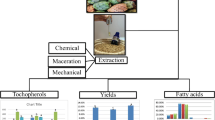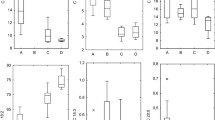Abstract
Puffing or popping is a common method of processingAmaranthus cruentus (Syn.Amaranthus paniculatus L. or Rajgeera) grain. Investigations into the effect of this processing treatment have shown the percent unsaturation in the oil to decrease from 75.5% to 62.3%. The maximum effect is on linoleic acid, the quantity of which decreased sharply from 46.8% to 27.0%. Squalene also increased by 15.5%, due to puffing of amaranth seeds.
Similar content being viewed by others
References
National Research Council,Amaranth: Modern Prospects for an Ancient Crop, Washington, National Academy Press, 1984, pp. 153.
Olusegun, O.L., inHandbook of Tropical Foods, edited by H.T. Chan, Jr., Marcel Dekker, Hawaii, 1983, pp. 1–28.
Saunders, R.M., and R. Becker, inAdvances in Cereal Science and Technology, Vol. VI, edited by Y. Pomeranz, St. Paul, American Association of Cereal Chemists, 1984, pp. 357–396.
Amaranth Today (Newsletter), Vol. 2, No. 1, Winter (1986), pp. 1–8, 33, East Minor St., Emmaus, PA.
Teutonico, R.A., and D. Knorr,Food Technol. 39:49 (1985).
Singhal, R.S., and P.R. Kulkarni,Int. J. Food Sci. Tech. 23:125 (1988).
Pant, K.C.,Nutr. Rep. Int. 32:1089 (1985).
Tudor, F., and B. George,J. Am. Oil Chem. Soc. 62:89 (1985).
Lyon, C.K., and R. Becker, —Ibid. 64:233 (1987).
Horwitz, W., (ed.)Methods of Analysis of the Association of Official Analytical Chemists, 13th edn., Association of Official Analytical Chemists, 1980, pp. 504–508, 519–520.
ISI Handbook of Food Analysis, Part XIII, Oils and Fats, Indian Standards Institution, New Delhi, 1985, pp. 72–76, 98–102.
Egan, J., R.S. Kirk and R. Sawyer, inPearson's Chemical Analysis of Foods, 8th edn. Churchill Livingstone, Edinburgh, London, Melbourne and New York, 1981, p. 537.
Windholz, M., inThe Merck Index, An Encyclopedia of Chemicals, Drugs and Chemicals, 10th edn., Merck and Co., Inc., 1983, pp. 8619–8621.
Ahmad, M.U., and S.K. Hussain,J. Oil Technol. Assoc. India 11:70 (1979).
Stoller, E.W., and E.J. Weber,J. Agric. Food Chem. 18:361 (1970).
Badami, R.S., and K.B. Patil, inFats, Oils, Related Food Products, Their Properties Symposium, edited by P.B. Rama Rao, AFST (India), 1976, pp. 141–142.
Author information
Authors and Affiliations
About this article
Cite this article
Singhal, R.S., Kulkarni, P.R. Effect of puffing on oil characteristics ofAmaranth (Rajgeera) seeds. J Am Oil Chem Soc 67, 952–954 (1990). https://doi.org/10.1007/BF02541855
Received:
Accepted:
Issue Date:
DOI: https://doi.org/10.1007/BF02541855




